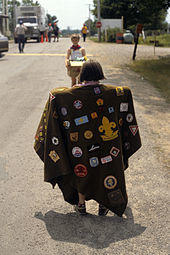
A collection of Scout badges, attached to a poncho, seen at the Fourth Pentathlon Jamboree in Fredericton, New Brunswick, 1986
Scout badges are worn on the uniforms of members of Scouting organisations across the world in order to signify membership and achievements. There is a great variety of badges, not only between the different national Scouting organisations, but within the programme sections, as well.
Background
Almost all badges are now made from cloth and are sewn onto the uniform shirt. In general, there are four types of badges worn by members of Scouting
- Group identity - Scouts belong to sub-divisions within their national organisations, and wear badges which identify which Scout Groups, Scout Districts, Scout Councils, or other divisions;
- Progressive awards - each section of Scouting has a number of long-term award programmes which reward the core principles of Scoutcraft, service, and adventure[1]
- Activity or proficiency awards - Scouts are able to undertake a large number of activities and, on completion of set criteria, are awarded recognition for these activities
- Special/event badges - from time to time, Scouts are able to wear special event badges, for example, to celebrate the Scouting 2007 Centenary
See also
References
- ^ Green, Clarke (2012-11-15). "First Class Rank in the First Year?". ScoutmasterCG. Retrieved 2012-11-15.